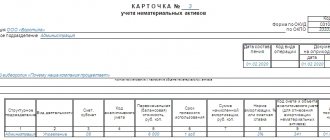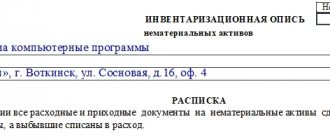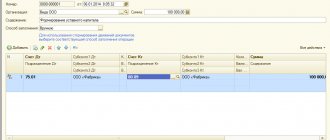PBU 14/2000 establishes a list of intangible assets, which includes rights to inventions, industrial designs and trademarks, as well as computer programs and databases. The business reputation of the organization and expenses for authorized and share capital are also classified as intangible assets. However, to classify an object as an intangible asset, a number of conditions must be met: its useful life must be more than 12 months, the organization must have all the necessary documents confirming its rights, benefit from the use of intangible assets in the present or future, and also use it for its own needs .
Accounting for intangible assets in 1C provides for the following operations:
- Acquisition and posting of intangible assets;
- Acceptance of intangible assets for accounting;
- Write-off of intangible assets in 1C 8.3;
- Inventory of intangible assets.
Acquisition and posting of intangible assets
To account for the acquisition of intangible assets, go to the menu “Fixed assets and intangible assets”, then “Intangible assets - Receipt of intangible assets”.
Fig.1 Receipt of intangible assets
The electronic document “Receipt of intangible assets” opens.
Fig.2 Electronic document “Receipt of intangible assets”
When you click the “Create” button, the “Receipt of intangible assets (creation)” document window will open (Fig. 3), in which you must fill in all the details sequentially. When selecting a counterparty, if only one agreement has been concluded with it, its details are entered automatically.
Fig.3 Receipt of intangible assets (creation)
We also fill in the remaining details sequentially. When you select an intangible asset, the directory menu “Intangible assets and R&D expenses” opens.
Fig.4 Intangible assets and R&D expenses
Click the “Create” button and sequentially fill in the directory details: full and short name of the intangible asset, group of objects, etc. (Fig. 5). In the line “Type of intangible assets”, 1C Accounting allows you to select the most suitable type of intangible assets for our case - Exclusive copyrights for computer programs (databases).
Fig.5 Exclusive copyright for computer programs (databases)
Also, when creating an intangible asset, you can immediately set its useful life by selecting a depreciation group (Fig. 6). Paragraph 1 of Article 258 of the Tax Code of the Russian Federation gives the taxpayer the right to independently determine the useful life of intangible assets and establish a depreciation group. In our example, we chose the fifth depreciation group with a useful life of 7 to 10 years.
Fig.6 Selecting a depreciation group
The cost of the software is 300.0 thousand rubles. Next, click “Pass and close” (Fig. 7). Please note that the program automatically entered intangible asset accounts 08.05 “Acquisition of intangible assets”.
Fig.7 Swipe and close
The registration of this document only reflects the receipt of intangible assets in 1C; the acceptance of intangible assets for accounting is formalized in a separate document with the same name. Below is a screenshot of the accounting entries generated when posting the document “Receipt of intangible assets”.
Fig.8 Receipt of intangible assets
Acceptance of intangible assets for accounting
To carry out this operation, let’s move on to the document “Acceptance for accounting of intangible assets” of the subsection “Intangible assets” of the section “Fixed assets and intangible assets”.
Fig.9 Acceptance of intangible assets for accounting
In the window that opens, click the “Create” button. In the pop-up window, fill in the date of acceptance of the intangible asset for accounting (as a rule, this is the date of its acquisition), then click on the line “Method of receipt”. The program provides a wide range of ways to receive intangible assets, including a contribution to the authorized capital or receipt under a lease agreement. In our example, we select "Purchase with a fee."
Fig. 10 Purchase for a fee
Next, we directly select the intangible asset itself. A pop-up window allows you to select from the entire list of intangible assets the one that we want to take into account.
Fig. 11 Selecting an intangible asset
In the “Accounting” tab, you need to specify the parameters for calculating depreciation and select the method of its calculation (in our case, linear).
Fig. 12 Parameters for calculating depreciation
When you hover your cursor over the line “Method of reflecting depreciation expenses,” 1C allows you to select one of the provided accounts for attributing costs, or, if necessary, create one yourself.
Fig. 13 Method of reflecting depreciation expenses
In our example, we select account 20.01 “Main production”. We have determined the useful life to be 120 months. Depreciation of intangible assets in 1C is accrued from the month following the month of this document, after the implementation of the routine operation “Closing the month”.
Fig.14 Selecting an account and period
Also, when accepting intangible assets for accounting, it is necessary to fill out the “Tax Accounting” tab.
Fig. 15 Filling out the “Tax Accounting” tab
In this tab, fill in the fields for the value of intangible assets, its useful life, as well as the procedure for including the cost in expenses. In this case, the program provides three ways to enable it:
- Include in depreciable property;
- Include in expenses;
- Do not include as expenses.
Carrying out this document will entail the following accounting entry.
Fig. 16 Accounting entries
Reasons for writing off intangible assets
According to clause 34 of the Regulations, the cost of a retiring asset or object that is no longer capable of generating economic benefits is subject to write-off in accounting. At the same time, the amount accumulated in the account is written off. 05 depreciation (when using this account). Possible reasons for disposal of intangible assets are:
- Completion of the established period of validity of exclusive rights to the asset.
- Transfer on the basis of alienation of the right to an object.
- Transfer of rights to an asset to other third parties, including due to collection or succession.
- The onset of obsolescence, leading to the impossibility of further use of the asset.
- The object's contribution to the authorized capital or mutual fund.
- Transfer of an asset under a gift/exchange agreement.
- Introducing intangible assets as a contribution to joint activities.
- Detection of the fact of shortage of an asset during inventory.
- Other circumstances.
Write-off of intangible assets in 1C 8.3
The write-off, as well as the transfer of intangible assets, are reflected in 1C by drawing up the appropriate electronic documents: “Write-off of intangible assets” and “Transfer of intangible assets” in the “Intangible assets” section.
Fig. 17 Write-off of intangible assets
When writing off an intangible asset, the user only needs to select the type of expense, the program automatically enters the write-off account and the intangible asset itself (since we only have one).
Fig. 18 Select type of flow
When you click the “Other income and expenses” line, a window with established templates for write-off opens. If necessary, it is possible to introduce a new type of income or expense. In our example, we select “Other non-operating expenses and income.”
Fig. 19 Other non-operating expenses and income
The document “Transfer of Intangible Assets” formalizes the fact of sale of an intangible asset to a third party, therefore, unlike the document “Write-off of Intangible Assets” (Fig. 20), this document contains the necessary details of the counterparty, numbers and dates of the sales agreement, etc. to be filled in.
Fig. 20 Write-off of intangible assets
The program automatically creates income and expense accounts, which can be edited if necessary.
Reasons for leaving
Disposal of intangible assets listed in the organization may occur for the following reasons:
- expiration of a certificate, patent or other documents that confirm the company’s right to use intangible assets;
- unsuitability of the asset for further use;
- transfer of an intangible asset to the authorized capital of other business entities;
- gratuitous transfer of intangible assets;
- sale of these assets.
Note 1
In accordance with paragraph 22 of Accounting Regulation 14/2000, the value of intangible assets that are no longer used for the purposes of producing products, providing services, performing work or to meet the management needs of the organization is subject to write-off.
In parallel with the write-off of the residual value of intangible assets, the amount of accumulated depreciation is also subject to write-off, if this amount was previously reflected in accounting in the accounting account $05$ “Depreciation of intangible assets.”
Too lazy to read?
Ask a question to the experts and get an answer within 15 minutes!
Ask a Question
Income and expenses received as a result of writing off intangible assets:
- reflected in the accounting records of the organization in the reporting period to which they relate;
- are included in the financial results of the organization.
The instructions for using the Chart of Accounts indicate that when writing off intangible assets, their value should be reduced by the amount of depreciation charges accrued during the period of operation, if depreciation was recorded on account $05$ “Depreciation of intangible assets.” This is reflected in accounting by the following entry:
- Debit $05$ “Amortization of intangible assets”
- Credit $04$ “Intangible assets”
The residual value of the disposed intangible assets is written off using the following entry:
- Debit $91-2$ “Other expenses”
- Credit $04$ “Intangible assets”
The balance of the $91$ “Other income and expenses” account is calculated every month by comparing debit and credit turnover. Then $91-9$ is written off from the subaccount to the $99$ “Profit and Loss” account.
Inventory of intangible assets
In a general sense, inventory is a comparison of accounting data with their actual availability. When conducting an inventory of intangible assets, it is necessary to be guided by the requirements of paragraph 3.8 of Chapter 3 of the Inventory Rules (Order of the Ministry of Finance of the Russian Federation dated June 13, 1995), as well as PBU 14/2007 “Accounting for intangible assets.”
In the standard documents of the 1C program version 8.3 you will not find the electronic document “Inventory of intangible assets”, since it is believed that intangible assets are not subject to actual inventory. At the same time, if an organization has decided to take inventory of intangible assets, it is necessary to create an external report of the form “Inventory list of intangible assets (Inv-1a)”, which is created in the “Configurator” mode. The report generates balances in account 04 “Intangible assets” for all objects accepted for accounting.







